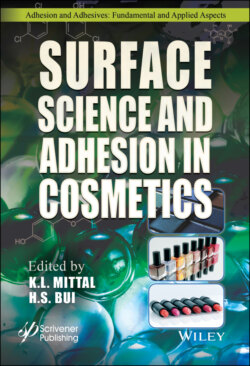Читать книгу Surface Science and Adhesion in Cosmetics - Группа авторов - Страница 36
2.2 Types of Natural Waxes, Their Physical Properties and Potential Applications
ОглавлениеNatural waxes originate either from animals or from plants. The chemical composition of wax contains a mixture of long-chain hydrocarbons, alcohols, free acids, and wax esters. The ester component is derived from long-chain fatty alcohol and fatty acid. Blake and coworkers reported the chemical composition of some common natural waxes in detail [7, 8]. It is observed that ester components are high (> 90%) for sunflower wax (SFW) and rice bran wax (RBW) but are lowest in candelilla wax (CLW) (<35%).
Waxes are commonly characterized through melting temperature, optical transparency, thermal expansion coefficient, surface tension, surface free energy, hardness and melt viscosity. The molecular weight, molecular weight distribution, percentage of crystallinity and morphology of waxes play important roles in the crystallization and melting temperature and the hardness of the waxes. Table 2.3 shows some physical properties of natural waxes for cosmetic application from wax suppliers [9] such as beeswax (BW), carnauba wax (CRW), candelilla wax (CLW), rice bran wax (RBW) and sun flower wax (SFW).
Table 2.3 Physical properties of typical natural waxes for cosmetic application [9].
| Natural wax | Melting Temperature Tm (°C) | Saponification value (mg KOH/g) | Acid value (mg KOH/g) |
| Beeswax (BW) [9b] | 62-65 | 89-103 | 17-24 |
| Carnauba wax (CRW) [9b] | 80-86 | 78-95 | 2-7 |
| Candelilla wax (CLW) [9a] | 68-73 | 43-65 | 12-22 |
| Rice Bran wax (RBW) [9a] | 77-82 | 75-120 | 13 max |
| Sunflower wax (SFW) [9a] | 74-77 | 78-92 | 8 max |
The differential scanning calorimetric (DSC) data from Blake et al. [7] show single and narrow endothermic and exothermic peaks for SFW and RBW while CLW exhibits broader and multiple endothermic and exothermic peaks. These results indicate that SFW and RBW are chemically more homogeneous than CLW. Therefore, the crystallization and melting temperatures (Tc and Tm) are dependent on the chemical composition and melting point of dominant components in the wax. Figure 2.1 shows the order of Tc and Tm of the natural waxes reported by Blake and coworkers [7, 8], wax suppliers [9] and by Dassanayake et al., [10]. In addition, the order of the melting enthalpy for natural waxes [8] is observed to be dependent on their ester components as shown in Figure 2.2.
With complex chemical compositions and a wide range of melting temperatures, the natural waxes have many interesting properties that can be applied to develop many potential cosmetic products as seen in Table 2.4.
Figure 2.1 Order of crystallization and melting temperatures (Tc and Tm) of natural waxes.
Figure 2.2 Dependence of melting enthalpy on esters component for natural waxes [8].
Table 2.4 Potential applications of natural waxes in cosmetics [9].
| Natural wax | Properties | Cosmetic application |
| Beeswax (BW) | High binding strengthPlasticizerExcellent emulsifiabilityImproves structure, oil retentionGood depositMold release for stick applications | Lipsticks Lip balms Mascara Hair styling Skincare cream |
| Carnauba wax (CRW) | Hardest natural wax, provides good texture and stability due to high TmEnhances oil retentionHas emollient and moisturizing propertiesForms durable film to protect skin | Lipstick Mascara Skincare cream Hair styling |
| Candelilla wax (CLW) | Has good glossForms a durable film and a low coefficient of contraction. | Lipstick Mascara |
| Rice Bran wax (RBW) | Hard waxThickenerSilky and non-tacky feelPlasticizerInhibits syneresis | Lipstick Creams Lotions Skincare cream Mascara Lip balms |
| Sunflower wax (SFW) | Emulsifier and thickenerImproves oil bindingEmolliency, lubricityFilm formation | Lipsticks Mascaras Lip balms Foundation Skincare cream |
Furthermore, waxes have been used in coatings, adhesives and inks to improve their adhesion to various substrates. The main advantage of using wax in the formulation is to improve the flexibility and extensibility of dried film. For example, the use of polyethylene wax (high Tm) in the coatings to improve slip and rub resistance, and of paraffin wax (low Tm) to reduce tack, improve slip and prevent tearing.
For developing a long-lasting of color lipstick, the rice bran wax has a potential to be used as gellant in the lipstick formulation since it can reduce the tack, or act as a plasticizer for high glass transition resins/film-formers or improve water repellency.
When using the long-wear lipstick, consumers feel their lips being dry over time. Therefore, they use the top coat containing oils to lubricate their lips for comfort. Sabale and coworkers [11] showed that rice bran wax could be used as occlusive moisturizer for skin. Thus, the rice bran wax can be used in the long-wear lipstick to maintain moisture for lips without the need to use the top coat. In addition, the high melting natural waxes such as rice bran, carnauba and sunflower waxes can enhance surface slip and rub resistance to improve the lasting of color of lipstick or mascara. Candelilla wax might be used in long-wear and non-transfer lipsticks to improve the shine/gloss and comfort after solvent evaporates. The use of carnauba and candelilla waxes in long-wear foundation can improve the stability of water/oil emulsion and reduce the film stickiness on the skin. Beeswax can be used as a wax dispersion in the cosmetic composition for skin and hair styling [12, 13]. Furthermore, Simonnet and coworkers utilized beeswax and a thermoplastic elastomer containing polystyrene in a dispersion form to improve the lasting of hair styling and the hair can be restyled for many cycles under thermal application [14]. In addition, beeswax dispersion was used with latex in semi-permanent mascara to enhance the volume of eyelashes and improve the removability of mascara with warm water [15]. Therefore, natural waxes have many potential applications in long lasting benefits in cosmetics and we need to explore them further.
